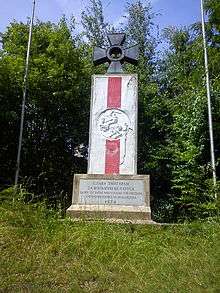Belarusian Americans
| Total population | |
|---|---|
|
750,000[1] | |
| Regions with significant populations | |
| New York, New Jersey, Cleveland, Chicago, Los Angeles, Detroit | |
| Languages | |
| Belarusian, Russian, American English | |
| Religion | |
| Predominantly Orthodoxy, Roman Catholicism, Judaism | |
| Related ethnic groups | |
| Russian Americans, Ukrainian Americans, Rusyn Americans, other Slavic Americans |
Belarusian Americans (Belarusian: Беларускія амэрыканцы, Biełaruskija amerykancy; Russian: Белорусские американцы, Byelorusskiye amerikantsy), also known by the somewhat dated terms Byelorussian Americans, Whiteruthenian Americans and White-Russian Americans, are Americans who are of total or partial Belarusian ancestry.
History
There is a suggestion that the first Belarusian immigrants to the United States, settling there in the early 17th century in Virginia, could have been brought by Captain John Smith, who visited Belarus in 1603.[2] The first wave of mass emigration from Belarus started in the final decades of the nineteenth century and continued until World War I. They emigrated to the United States via Libava and northern Germany. When they arrived, most settled in New York, Philadelphia, Boston, and Baltimore. However, most of these first Belarusians were registered either as Russians (those who were Orthodox Christians) or as Poles (Roman Catholics). Most Belarusians who immigrated to the United States after World War I were political immigrants, mainly from western Europe and Poland. There were only several thousands of them. Very few Belarusians, mostly from Jewish-Belarusian families, came to the USA between the late 1930s and the end of 1941.[2]
In the post-World War II period, from 1948 to the early 1950s about 50,000 Belarusians immigrated to the United States; most of them left Europe for political reasons. These immigrants were former prisoners of war from the Polish and Soviet armies, persons who had worked in Germany as Ostarbeiters during the World War II, former émigrés who left Belarus shortly after the war or in 1939 when the Soviets attacked Poland, refugees who had fled Belarus in 1943 or 1944, and defectors and dissidents after World War II. They came from many countries where they had settled after World War II. The majority of them came from West Germany and Austria. Many Belarusians who came from Great Britain, France, Italy, Belgium, Denmark, and other countries in South America and North Africa.[2]
During the 1980s and 1990s the waves of Belarusians that emigrated to the United States were relatively small compared with previous waves. People have emigrated for political, economic, and family reasons. Most of these immigrants are of the Jewish-Belarusian descent. The 1980 U.S. census counted 7,328 Belarusians in the United States, but the 1990 census registered only 4,277 Belarusians.[2]
Demography

According to the 1990 US Census, only 4,277 respondents claimed Belarusian ancestry; there are no reports as to the estimated population from the 2000 census.[3] The precise number of Belarusian Americans is difficult to determine, as census and immigration statistics did not historically recognize Belarusians as a separate category. Many of them were recorded as Russian or Polish, depending on the region of Belarus where they were born.
The largest concentrations of Belarusian Americans are in the metropolitan New York area, New Jersey (especially Highland Park and South River), Cleveland (and its suburbs), Chicago (recent immigrants concentrated around Wheeling), Los Angeles, and Detroit.
There were several waves of Belarusian influx into the USA, one before the Russian Revolution, then in 1919-1939 from West Belarus, then in the late 1940s-early 1950s (after the Second World War), and after the collapse of the USSR in the 1990s.
One major group of Belarusian immigrants to the U.S. are Belarusian Jews who migrated starting in the mid-19th century, having faced discrimination in the Russian Empire, which Belarus was part of at the time.
According to the 2000 Census Bureau report,[4] 38,505 people who were born in Belarus lived in the USA. Of them, 1,363 spoke the Belarusian language at home.[5]
Education and culture
There are several organizations in the United States that have developed a system of secondary schools in places with communities of Belarusian descent. These organizations have the goal of teaching the language, culture, and religious traditions of Belarus. Thus the Belarusian culture is represented by choirs, theatrical groups, and musical and dance ensembles. One of the more prominent associations is the Belarusan American Association.[2]
In the 1950s the St. Euphrosynia Belarusian Orthodox Church was created in South River, New Jersey.
Notable Belarusian Americans
- Dick Dale
- Alex Galchenyuk
- Wayne Gretzky
- Tadeusz Kościuszko
- Olga Korbut
- Lisa Kudrow
- Nikolai Sudzilovsky
- Gary Vaynerchuk
- Harrison Ford
- Kirk Douglas
References
- ↑ Как живешь, белорусская диаспора? [How are you, Belarusian diaspora?]. belarustime.ru (in Russian). 2006. Archived from the original on March 13, 2012.
- 1 2 3 4 5 Vituat Kipel (2006). "Belarusan Americans". everyculture.com. Retrieved January 14, 2016.
- ↑ "Belarus". Slavic Heritage Coalition. 1996. Archived from the original on December 29, 2013.
- ↑ "Profile of Selected Demographic and Social Characteristics: 2000 - People Born in Belarus" (PDF). U.S. Census Bureau. 2000. Retrieved January 14, 2016.
- ↑ "Detailed Languages Spoken at Home and Ability to Speak English for the Population 5 Years and Over for the United States: 2006-2008". U.S. Census Bureau. April 2010. Archived from the original (XLS) on October 19, 2010.
External links
- Belarusian Youth Movement of America
- The Belarusan-American Association
- The international seminar Belarusian Diaspora: Past and Present took place in Minsk